The Selfish Seamstress is feeling pretty smug because she’s come up with a foolproof way to do perfectly symmetrical plaid (and stripe) matching. She has searched the web and a couple of sewing books for instructions on how to match plaids, and has yet to see this method. She’s therefore convinced that she came up with it herself, even though it’s so obvious that people have surely done this before. As you may know, I like to take credit even where no credit is due.
Plaid matching at seams can be one of the more frustrating aspects of sewing. It’s no fun finding out that the two legs of your pants don’t match because you aligned something incorrectly. My little trick applies to situations when you want to cut two mirrored pieces, for example two pant fronts, two skirt side panels, two identical halves of a waistband. Essentially any situation when you want two identical pieces, with one of them flipped over.
There seem to be two primary schools of thought on how to match plaids. The first school is to fold the fabric *very* carefully in half, making sure that the top layer and bottom layer are perfectly matched, then put your pattern piece on top and cut through the double thickness as usual. I think this is really the worst way you can do it. Even if you’re really careful, it is just too easy to have it slightly off somewhere. And if you’re cutting a big piece, say two pant fronts, good luck being completely sure that your layers are aligned the whole way through. Once the fabric is folded in half, there’s really no good way to look at the bottom layer.
The second school of thought is to open the fabric out in a single layer, lay down your pattern piece, cut it out, and then flip the pattern piece over and find another spot on the fabric where you can match the notches to their location on the first piece you cut out. This method is conventionally accepted as the “right” way to do it, and this is what I had mostly been doing all along. This can, however, still lead to some imprecision. Particularly if you’re working with a large plaid in which small inaccuracies can be ridiculously noticeable. Think about a Burberry type plaid. You might estimate that a notch falls about 1/3 of the way between two stripes, but if you’re even just a couple of millimeters off, it’s going to be noticeable in the end.
And then I figured out this neat trick:
The Selfish Seamstress Method of Plaid (and Stripe) Matching
(Note: I will continue to take full credit for this until someone (probably soon) points me to a bunch of other folks that recommend doing this. The Selfish Seamstress needs to pat herself on the back a lot.)
I made a little “toy” skirt back pattern and am using a remnant to illustrate.
First cut out your pattern piece and lay it on your fabric as desired:
Cut out your piece as you normally would…
Okay. This is the point at which conventional wisdom would have you flip the pattern piece over and try to match the notches to the piece you just cut, like so:
You can already see this is not so easy to do. It’s even harder if you don’t have that nice skirt-shaped hole to look at. AND it’s even harder still if you’re working on the bias. Are those notches in the same place? Close enough? I’m getting an ulcer just thinking about it.
The Selfish Seamstress Method recommends that instead of using the pattern piece to cut the second skirt back, you instead use the skirt piece you just cut, remembering to flip it over for mirror symmetry, and match it to the plaid in the fabric:
Oh my goodness, you can probably barely even see it. That’s because it’s SO MATCHED. Don’t worry, it’s easier to see when you do it in real life. Just use plenty of light. Here- maybe it’s easier to see once it’s pinned in place:
Or maybe not. But you should get the idea. You can totally tell if your plaid is matching or not, and it’s easy to line up because you’re not just relying on the notches, you’re using the whole plaid as a grid you can match. Now cut around the first piece, being careful not to cut into the first piece, and also being careful not to cut the second piece larger than the first piece. Snip snip snip and flip…
Voila! Perfectly symmetrical left skirt back and right skirt back! There’s no way that won’t match when you sew the center seam.
Of course, this isn’t the complete solution to all of your plaid and stripe matching woes. You’ll still need to match notches for other seams, such as matching the skirt front to the skirt back. But at least this way you’ll know that your right and left sides are the same. And that’s it!

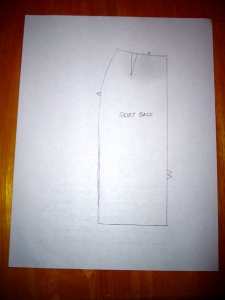
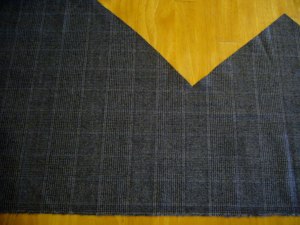
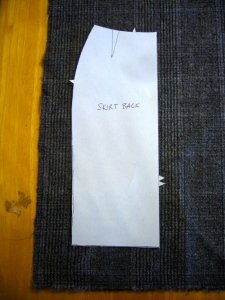
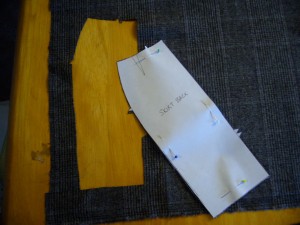
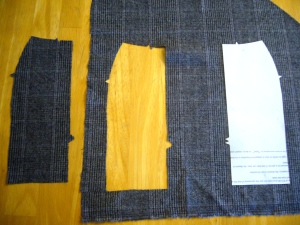
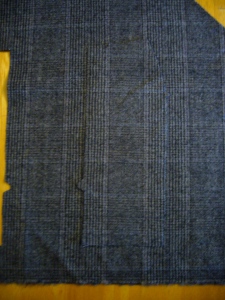

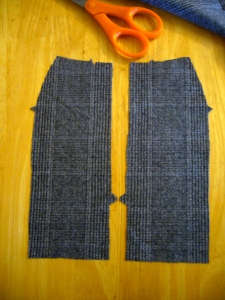





27 comments
Comments feed for this article
October 27, 2009 at 7:03 pm
Kayy
Well, I didn’t read it in a book (or if I did I can’t remember) but I do this too :)
October 27, 2009 at 8:09 pm
juebejue
how smart! I never saw that method before, so I will remember it as yours! ;) time for some plaid goodness!
October 28, 2009 at 9:06 am
jj
How about sewing the back center seam first (matching of course) and then cut everywhere else?
October 28, 2009 at 11:27 am
Jenadina
Brilliant!
October 28, 2009 at 6:34 pm
Angela
I’ve always been scared to sew with plaids or stripes because of the matching, but this makes it seem so simple. :) Thanks for the tip!
October 29, 2009 at 10:43 pm
Raye Ann
i haven’t researched it at all, and haven’t sewn with plaid since I decided to care about such things as plaid matching… but this is exactly how my “head” says to do it:)
December 15, 2009 at 3:27 pm
Skitzo Leezra Studio
Brilliant!
(Really appreciate the photos, it makes everything so much clearer.)
December 15, 2009 at 5:08 pm
Anjanette
love it. Thanks for the tip.
December 26, 2009 at 3:13 pm
Michelle
I have avoided plaids because I have never had much luck lining them up and being even a little off bothers me….bad. Thanks for the tip. Maybe I’ll be able to add plaids back into my sewing.
January 1, 2010 at 3:50 pm
Trudy Callan
This is so wonderful! Thank you! Thank you! Thank you!
February 27, 2010 at 2:10 pm
The stripes are conspiring against me « The Selfish Seamstress
[…] used my usual trick for doing symmetrical plaid matching. But this time, it didn’t work! I couldn’t get the stripes to match. What! […]
February 27, 2010 at 2:59 pm
Pavlina
Score! I just never bothered to match my stripes and always avoided the plaids like the plague. This makes total sense.
February 27, 2010 at 5:25 pm
K-Line
Thank you for this! I’ve been wanting to sew with an even plaid but I couldn’t figure out an easy way to do it.
August 16, 2010 at 8:54 pm
Picnic by the Sea Dress « Petite Republic
[…] back seams than the one on the pattern, by using selfish seamstresses’s plaid matching method here. I didnt try to match up the side, but they look fine to me even though they are slightly off. I […]
November 12, 2010 at 12:49 pm
Celeste copycat dress « Lin3arossa's Blog
[…] really happy about the plaid matching in the upper front and back, which I achieved based on the (in)famous Selfish seamstress’s method. This is a nice pattern that went together fairly well. The instructions are burdaStyle-like i.e. a […]
December 29, 2010 at 6:25 pm
sadoo
I’ve been sewing since i was a kid 55 yrs ago, and this is how i always did it, it seen to be common sense to me. Happy sewing ;)
January 26, 2011 at 6:37 pm
Christina
Your tip helped me with my first uneven plaid project. Thank you!
March 10, 2011 at 11:29 am
Elizabeth Barnett
this is the way they taught us in high school “Home Economics” …
August 15, 2011 at 7:55 pm
YSL Wedding Dress (or, Adventures in Tartan) « PatternVault
[…] I ended up using a technique I first learned of from the Selfish Seamstress (read her blog post here): cutting one set of pieces from a single layer of fabric, then flipping the pieces and using them […]
September 15, 2011 at 7:35 am
Matching Plaid « VickikateMakes
[…] how I (hope I’ve) matched the plaid design on the pattern. And I unashamedly credit the Selfish Seamstress herself in educating me in this […]
October 1, 2011 at 5:33 am
whatthesally
I dont often work with repeating symmetrical patterned fabric, but I was trying to find ways around matching up the patterns with some fabric I love and thought back to this. I havn’t finished the dress yet, but thankyou in advance. I love anything that makes me look like I can sew better than I actually can.
January 26, 2012 at 10:48 am
Sassy T
Fabulous tip. I am a beginner and just about to deal with plaid for a bag lining. Thought it would be good opportunity for me to try and match plaids.
November 8, 2012 at 10:11 pm
Tracey
Its great that you documented the method! I’ve never seen it written down. It is the method my 7th grade sewing teacher taught. Back when there was a classroom of sewing machines, and kids were taught not to sew over their fingers, and if you did anyway, your parents said you were a knucklehead and didn’t sue the district.
December 3, 2012 at 6:13 pm
Barbara Owsley Lamar
I’m getting ready to do a plaid shirt, which is why I did a search on “matching plaids.” I like your method better than any other I’ve seen. Thanks for sharing it!
February 12, 2013 at 11:22 am
Debbie
What about scooting one piece over the distance of the seam allowance and then the plaid really would look like one continuous piece. ?
December 5, 2013 at 5:05 pm
Sewing with stripes and checks | Cut the cloth
[…] And another great one from The Selfish Seamstress […]
October 4, 2014 at 1:55 pm
Saturday Musings: Selfish Sewing | Making the Flame
[…] or writing, or working, but left their mark nonetheless. Look at this five year old tip for matching plaids from The Selfish Seamstress; or this more recent tip for getting bias tape in the right color from […]